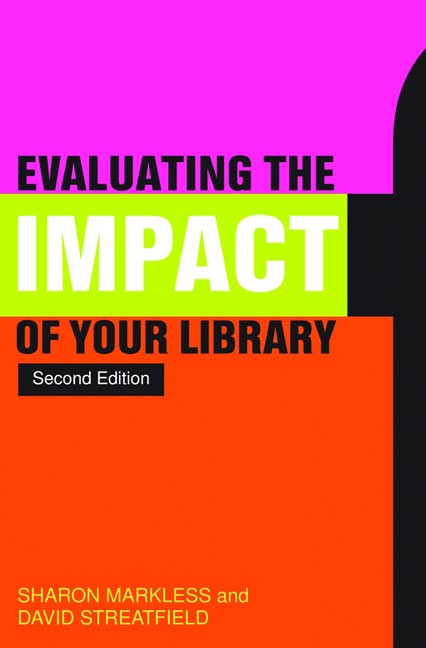Book contents
- Frontmatter
- Dedication
- Contents
- Introduction
- About the authors
- Impact and all that: use of some key terms in this book
- Part 1 The Context
- Part 2 Evaluating Impact
- 4 Putting the impact into planning
- 5 Getting things clear: objectives
- 6 Success criteria and impact indicators: how you know you are making a difference
- 7 Making things happen: activities and process indicators
- 8 Thinking about evidence
- 9 Gathering and interpreting evidence
- 10 Taking stock, setting targets and development planning
- Part 3 The Bigger Picture
- References
- Notes
- Index
- Evaluating and Measuring the Value, Use and Impact of Digital Collections
- Measuring Library Performance
- Miscellaneous Endmatter
6 - Success criteria and impact indicators: how you know you are making a difference
from Part 2 - Evaluating Impact
Published online by Cambridge University Press: 08 June 2018
- Frontmatter
- Dedication
- Contents
- Introduction
- About the authors
- Impact and all that: use of some key terms in this book
- Part 1 The Context
- Part 2 Evaluating Impact
- 4 Putting the impact into planning
- 5 Getting things clear: objectives
- 6 Success criteria and impact indicators: how you know you are making a difference
- 7 Making things happen: activities and process indicators
- 8 Thinking about evidence
- 9 Gathering and interpreting evidence
- 10 Taking stock, setting targets and development planning
- Part 3 The Bigger Picture
- References
- Notes
- Index
- Evaluating and Measuring the Value, Use and Impact of Digital Collections
- Measuring Library Performance
- Miscellaneous Endmatter
Summary
This chapter guides you through stage two of your quest to evaluate impact: choosing success criteria and using them to write specific impact indicators. The key question at this stage is ‘How can I tell if I am making a difference?’ or, to put it another way, ‘What do I want to be judged on in relation to each of my service objectives?’ Designing indicators is one of the most critical steps in the whole process of evaluating impact.
Let us start with two more traps for the unwary.
When we talk about the elephant trap in section 5.4.4, this is because we have seen so many library service managers slide from writing objectives into listing what they expect to do to achieve them. We've come to the conclusion that this happens because the driving motivation for most library managers is to provide as wide a range of services as possible for everyone. Where this is feasible there is no problem, but when resource limitations kick in it is necessary to start asking questions about what works best.
The same problem crops up at this stage, but with the subtle difference that people slide from ‘How can I tell if the service is making a difference’ to ‘How well are we doing this?’ As Linley and Usherwood (1998) say:
Even where people have sought to assess the libraries’ performance against goals … the emphasis [is] on developing indicators of administrative effectiveness, that is of process.
The second trap to beware of is that it is easy to slide into the problems of collecting the evidence needed to inform your indicators, rather than sorting out the indicators and then worrying about the evidence. This leads to library managers shying away from indicators that might be difficult to measure.
Working through this chapter should help you to avoid these traps.
Laws Of Impact Evaluation 4
When you are thinking about what impact you would like to see, don't inhibit yourself by worrying about how you will gather the evidence – yet!
Formulating success criteria: getting the balance right
You should now be ready to translate your service objectives into success criteria. If you have written clear objectives, you should be able to answer the questions:
• What sort of changes am I looking for in the people that I want to reach with this service objective? or
- Type
- Chapter
- Information
- Evaluating the Impact of Your Library , pp. 79 - 104Publisher: FacetPrint publication year: 2012



